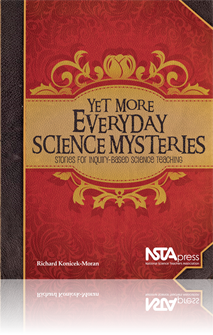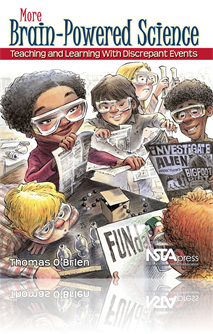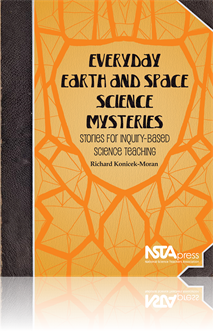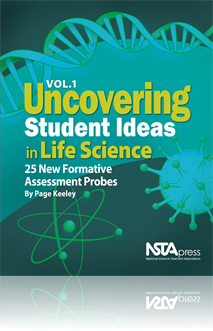All Book Chapters
Book Chapter
There is currently a strong effort to combine science and literacy, because a growing body of research stresses the importance of language in learning science. Discussion, argumentation, discourse of all kinds, group consensus, and social interaction...
Book Chapter
The purpose of this story used in this chapter is to help students learn about the source of heat energy that warms their planet. Of course that is the Sun, and it only has an effect on the temperature of the Earth when it is shining on a particula...
Book Chapter
The author’s research and that of others show that children have a difficult time understanding the recycling of organic matter in an ecosystem. The story in this chapter aims to have students speculate about what happens to organic material over t...
Book Chapter
What’s the Moon Like Around the World?
A great deal of confusion arises from the lack of understanding about the Moon’s journey around the Earth and its apparent shape changes. This investigation is aimed at confronting this confusion by looking at the Earth-Moon system and how it appea...
Book Chapter
Astronomical rules are not always correct, especially when they use the word “always.” Students should learn that unless they live on or very near the equator, there are only two days in the year that the Sun rises directly in the east—the sp...
Book Chapter
Lichens are everywhere, yet most people fail to notice them because they are so familiar. The story in this chapter was written to help persuade teachers to acquaint their students with these unique forms of life. Many biology teachers tend to gloss ...
Book Chapter
Comeback Cans: Potentially Energize “You CAN Do” Science Attitudes
Learners predict-observe-explain the rolling behavior of the two cans in terms of kinetic and potential energy conversions and friction. Two seemingly identical opaque cans are set against each other in a race on a flat surface. Initially, both can...
Book Chapter
Follow That Star: <i>National Science Education Standards</i> and True North
Earth’s magnetic field and its effect on compasses can help people find their bearings relative to a fixed target or direction. In this activity, many learners will have difficulty locating their compass bearings if they are inside a room (especi...
Book Chapter
“Horsing Around”: Curriculum-Instruction-Assessment Problems
The nature of science (NOS) involves actively seeking (rather than avoiding) challenging problems that may require looking at situations differently and thinking outside of artificially imposed constraints. Science, like art, is a creative endeavo...
Book Chapter
Magical Signs of Science: “Basic Indicators” for Student Inquiry
Advertisements capture consumers’ attention and motivate them to buy certain products. Similarly, teachers need to sell science to students by walking the talk of research-informed best practices. Magic signs with (dis)appearing messages (or col...
Book Chapter
Verifying Vexing Volumes: “Can Be as Easy as Pi” Mathematics
Mathematics is both a key to unlocking the secrets of nature and, for many students, a stumbling block to conceptual understanding in science. In this activity, two sheets of 8.5 in. × 11 in. paper are used to construct two cylinders with surprising...
Book Chapter
Bottle Band Basics: A Pitch for Sound Science
In this activity, three identical-size glass soft drink bottles with varying amounts of water are used to make sounds of various pitches. Upon initial consideration, the pattern established when using the bottles as wind instruments seems to suggest ...
Book Chapter
Metric Measurements, Magnitudes, and Mathematics: Connections Matter in Science
This model-building activity helps learners visualize SI’s base-ten relationships; the connections between the meter, liter, and gram; the real-world relevance of mathematics to science; and the somewhat abstract concept of powers of ten that is so...
Book Chapter
Cookie Mining: A Food-for-Thought Simulation
In this activity, various brands, sizes, and textures of chocolate chip cookies are “mined” as an edible analogy for natural resource management and conservation....
Book Chapter
Teachers (or students) are asked to generate and discuss a list of the Top 10 Crazy Ideas in Science and a related list of Top 10 Challenges of Learning Science. This brainstorming activity focuses on science as a school subject that can be mindless...
Book Chapter
In this activity, the wording and validity of the scientific and economic claims for compact fluorescent lightbulbs (CFLs) are critically examined. Their environmental impact relative to standard incandescent lightbulbs is also discussed....
Book Chapter
A Terrible Test That Teaches: Curriculum-Embedded Assessment
In this activity, a “terrible test” appears to be impossible to pass. However, it is intentionally designed to include common errors in item construction that, if noticed, allow the test-wise learner to ace the test without any prior knowledge of...
Book Chapter
Diagnostic Assessment: Discrepant Event or Essential Educational Experiment?
In this activity, learners are asked to complete sample diagnostic assessments that model how nongraded, preinstructional “tests” support learner-centered curriculum and instruction. These kinds of tests, the specific questions asked, and the mis...
Book Chapter
Dual-Density Discrepancies: Ice Is Nice and Sugar Is Sweet
Seemingly identical crystalline cubes (ice versus halite crystals) are observed to either sink or float in two seemingly identical clear, colorless liquids (ethanol and water). Also, a handful of sugar cubes are observed to sink in a container of ...
Book Chapter
Inferences, Inquiry, and Insight: Meaningful “Miss-takes”
The Nature of Science (NOS) includes making scientific inferences based on available empirical evidence (observation) and logical arguments (e.g., prediction based on pattern recognition). Making and learning from “miss-takes” uncovered via sk...
Book Chapter
Pseudoscience in the News: Preposterous Propositions and Media Mayhem Matters
The nature of science (NOS) is to rely on empirical evidence, logical argument, and skeptical review, versus pseudoscience (e.g., astrology), which falsely claims scientific validity and credibility despite the weight of contradictory evidence. Both...
Book Chapter
Scientific Reasoning: Inside, Outside, On, and Beyond the Box
Direct observation, measurement, indirect evidence, and inferential reasoning are used to uncover nature’s patterns and their underlying logic. Scientists use both data interpolation and extrapolation, as well as new technologies, to find ways to p...
Book Chapter
Magic Bus of School Science: “Seeing” What Can’t Be Seen
Scientists use direct empirical and inferential evidence, logical argument, and skeptical review to formulate and evaluate hypotheses and tentative, provisionally accepted theories. In this activity, a simple line-sketch drawing of a school bus cues ...
Book Chapter
Reading Between the Lines of the Daily Newspaper: Molecular Magic
Although there is no single scientific method, scientists use the triple tests of empirical evidence, logical argument, and skeptical review to discover patterns in nature and explain their underlying reasons in terms of naturalistic theories that re...
Book Chapter
Pondering Puzzling Patterns and a Parable Poem
Students and teachers need playful experiences where they can develop the scientific inquiry skills of observation, pattern recognition, and inferential reasoning and prediction, as well as discover some of the perceptual and conceptual biases of hum...
Book Chapter
Astronomical rules are not always correct, especially when they use the word “always.” Students should learn that unless they live on or very near the equator, there are only two days in the year that the Sun rises directly in the east—the sp...
Book Chapter
What's the Moon Like Around the World?
A great deal of confusion arises from the lack of understanding about the Moon’s journey around the Earth and its apparent shape changes. This investigation is aimed at confronting this confusion by looking at the Earth-Moon system and how it appea...
Book Chapter
The purpose of this assessment probe is to elicit students’ ideas about infectious diseases. The probe is designed to reveal whether students recognize that antibiotics only work on bacterial infections, not viral infections....
Book Chapter
The purpose of this assessment probe is to elicit students’ ideas about the smallest parts of living and nonliving things. The probe is designed to determine how students distinguish between cells and atoms in living and nonliving contexts. ...
Book Chapter
The purpose of this assessment probe is to elicit students’ ideas about the plant structure where photosynthesis takes place. The probe is designed to reveal whether students recognize that food is made within the leaf of a plant. ...
Book Chapter
The purpose of this assessment probe is to elicit students’ ideas about living things. The probe is designed to determine whether students recognize that seeds are living when they are in a dormant state. ...
Book Chapter
The purpose of this assessment probe is to elicit students’ ideas about “plant food.” The probe is designed to reveal whether students recognize that plants use the sugars they make as their food. ...
Book Chapter
The purpose of this assessment probe is to elicit students’ ideas about the flow of energy in a trophic relationship that children are most familiar with—food chains. The probe is designed to find out if students recognize that most of the energ...
Book Chapter
The purpose of this assessment probe is to elicit students’ ideas about the transfer of matter and energy in ecosystems. The probe is designed to reveal whether students recognize that only matter is cycled through an ecosystem. ...
Book Chapter
The purpose of this assessment probe is to elicit students’ ideas about adaptation. The probe is designed to reveal whether students hold Lamarckian ideas about individual organisms adapting to changes in the environment. ...
Book Chapter
The purpose of this assessment probe is to elicit students’ ideas about sexual reproduction. The probe is designed to reveal whether students recognize that multicellular organisms develop from a fertilized egg. ...
Book Chapter
The purpose of this assessment probe is to elicit students’ ideas about life cycles. The probe is designed to see if students recognize that the pupal stage of a life cycle is a living organism. ...
Book Chapter
The purpose of this assessment probe is to elicit students’ ideas about structures they encounter when they learn about heredity. The probe is designed to reveal students’ ideas about the “parts and wholes” relationship between DNA, genes, an...
Book Chapter
The purpose of this assessment probe is to elicit ideas about genetic traits. The probe is designed to see if students recognize that some traits, such as eye color, are complex and cannot be predicted solely by the result of one gene. ...
Book Chapter
The purpose of this assessment probe is to elicit students’ ideas about the cellular makeup of the human body. The probe is designed to see if students recognize that the body is an organized collection of cells and not a structure or “outline...






